What to know about the 2024 solar eclipse in VT: It's expected to bring 250,000 tourists
A rare astronomical phenomenon could propel Burlington to stratospheric heights, metaphorically speaking, as it will be one of the best places for viewing the Great North American Solar Eclipse on April 8, 2024.
Northern Vermont will be in the path of totality − a narrow slice of geography with an optimal view of the moon perfectly in line with the Sun.
Sky watchers are expected to descend en masse upon Burlington and northern Vermont.
Some projections say the Green Mountain State could swell by 250,000 people over the span of about four days, increasing the population by 40%. Tourism experts expect this to be a huge boon for Vermont, which usually experiences its lowest visitation rates during the month of April, and businesses are already capitalizing on the moment.
Though still a long way out, experts say you may want to start preparing now. From finding equipment and solar glasses, to what to expect from local events, booking hotels, staking out a good place for viewing, or throwing your own eclipse party here is a guide to this once-in-a-lifetime event.
'You'll never forget it': Total solar eclipse is one year away. Get ready now!
When was the last solar eclipse in Vermont
It's been 92 years since Vermont was in the path of totality for a solar eclipse and it will be 21 years (2045) before another total solar eclipse will be seen in the U.S., though not in Vermont.
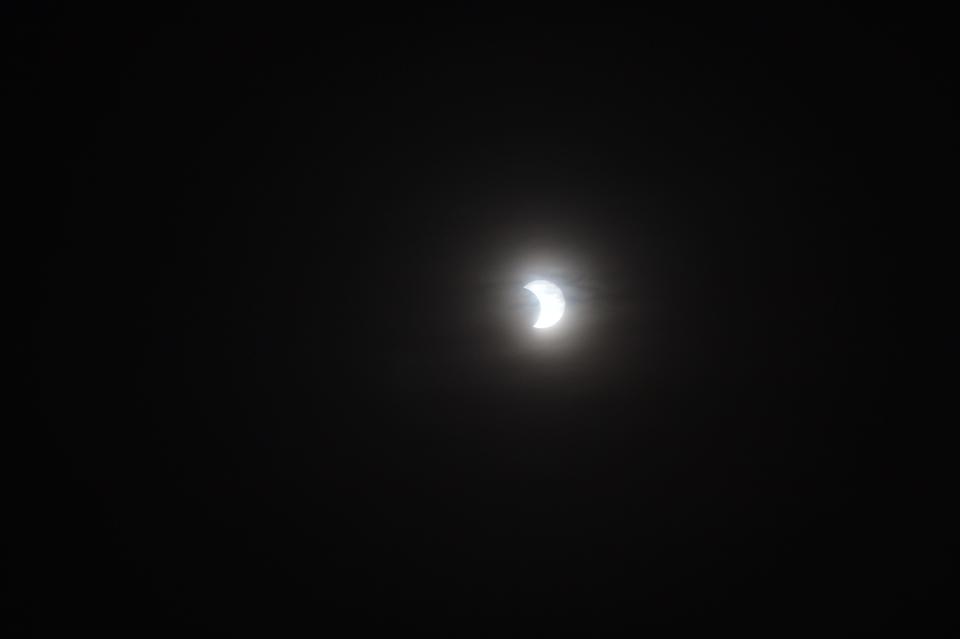
What is a solar eclipse?
A total solar eclipse occurs when Earth, the moon and the sun are in syzygy − alignment − during which the moon moves between the sun and Earth and blocks the solar light from reaching Earth.
During the totality, it should get very dark and it is the only time you would be able to see the sun's corona, as well as colorful lights in the chromosphere and solar prominences with your eyes because the moon will be blocking out the most extreme source of light. You should feel a temperature drop and animals may begin to act like it is nighttime.
This particular eclipse is also special in that the distance the moon and sun will be from Earth at that time will make the relative sizes of the two objects appear about the same. That means the moon will completely blot out the sun and not show the ring of fire other total eclipses have.
What time is the April 8, 2024, solar eclipse?
Starting at 2:14 p.m. on April 8 in Burlington, the moon will begin to appear to move in front of the sun. Totality will be between 3:26 and 3:29 when the moon will be a dark ball over the sun casting our area into shadow, called the umbra. By 4:37 p.m. the moon will have moved past the sun returning the light to normal.
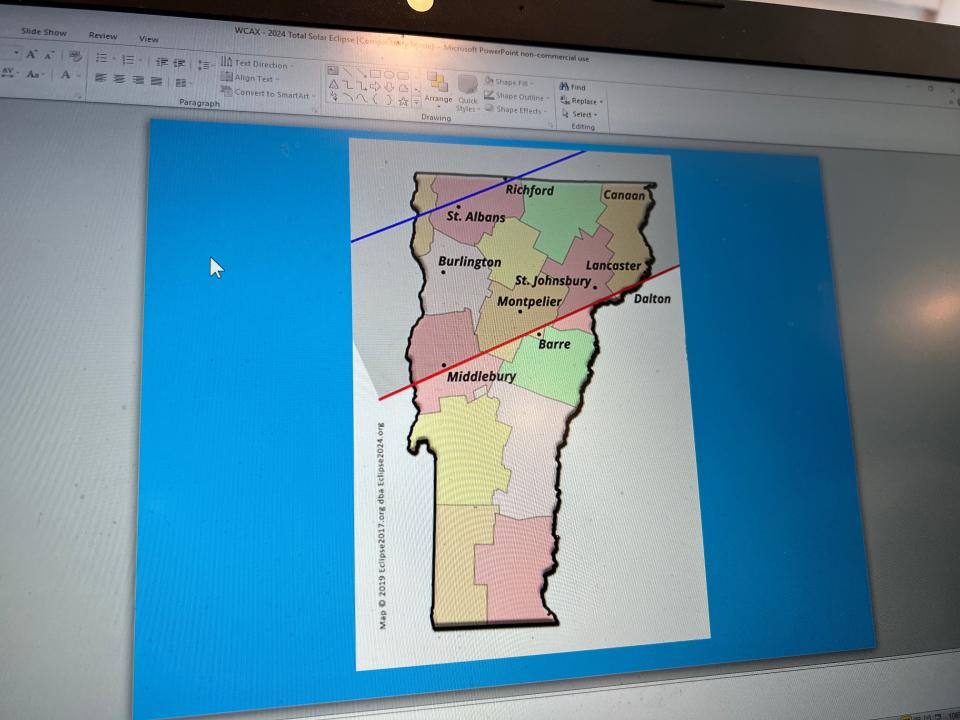
What is the path of totality for the solar eclipse
Vermont towns that will be in the path of totality include Barre, Burlington, Johnson, Middlebury, Montpelier, Newport, Saint Albans, St. Johnsbury, Stowe and Waterbury.
Across North America, notable cities in the path of totality include Mazatlán and Torreón, Mexico; San Antonio, Austin and Dallas, Texas; Little Rock, Arkansas; Indianapolis, Indiana; Cleveland, Ohio; Buffalo and Rochester, New York; Burlington, Vermont; and most of Montreal, Canada.
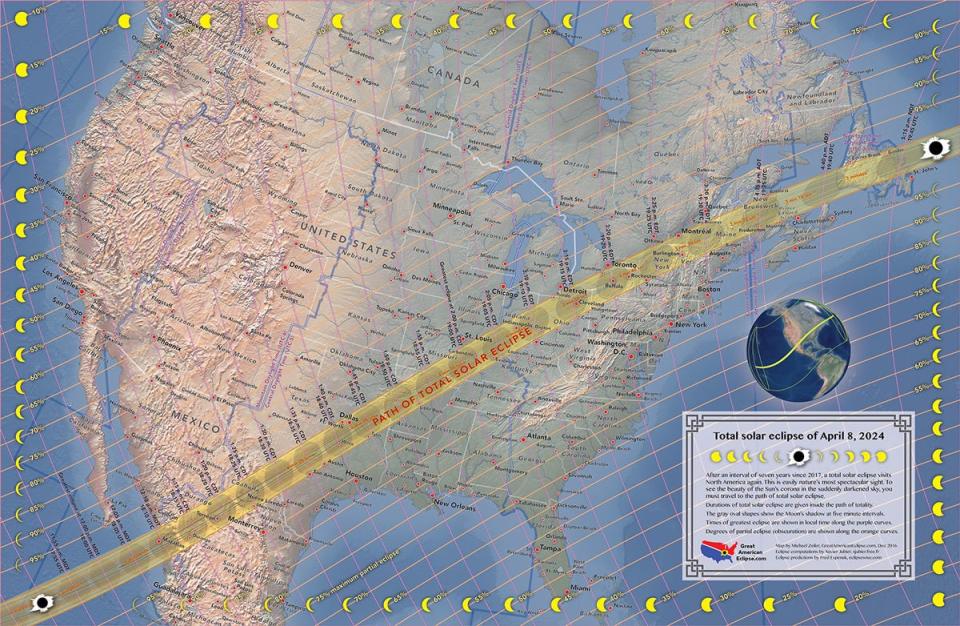
Is it safe to watch an eclipse?
While partial solar eclipses and most total solar eclipses must be viewed through special lenses so as not to damage your eyes, during the three minutes when the moon will totally obscure the sun, you can safely take off your glasses and look up at it with the naked eye.
Eclipse tourism big business for Vermont - hotels go for $500 to $1,000 a night
The event could bring serious cash to the area. A Saint Albans Messenger article said a dozen room reservations had been made at the Hampton Inn, with bookings costing at least $1,000 a night. A quick look at hotels and rentals near Burlington showed many rooms going for between $300 and $600 a night and some intrepid homeowners offering up their entire homes for $1,100.
The eclipse falls on a Monday, so that day plus the preceding weekend is when visitors are expected to arrive. Jeff Lawson, vice president of tourism for the Lake Champlain Regional Chamber of Commerce, said there has already been very high interest in hotel bookings for that three- to four-day period. Visitors should expect to pay higher than normal prices. The increased rates are not stopping anyone as far as Lawson could tell.
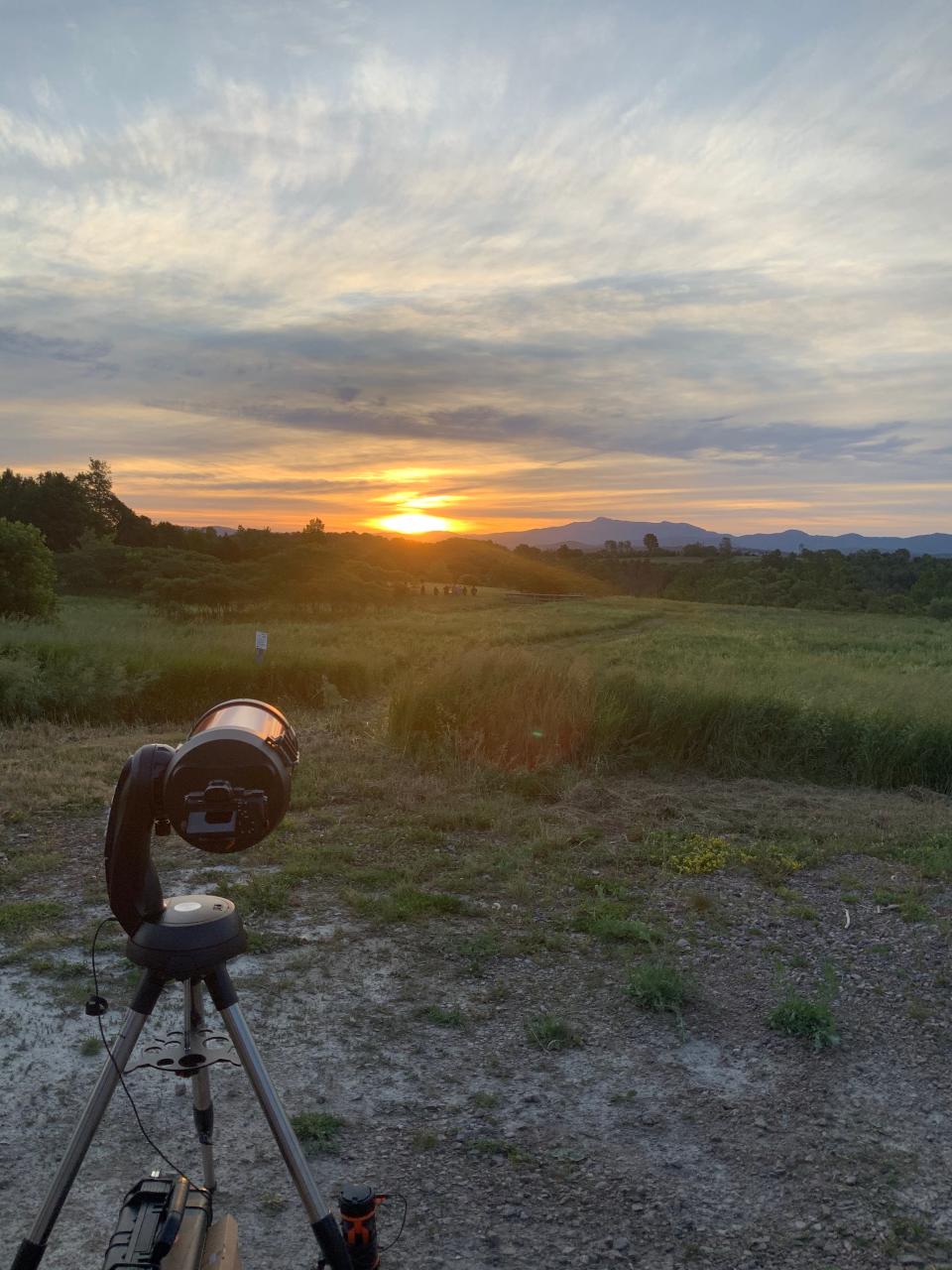
He said it is falling out of the sky and into our laps at the best possible time during Vermont's shoulder season between skiing ending and summer tourism beginning. He's talked with other cities that were in the path of totality in 2017 so he expects the impact on the area to be significant. In addition to bringing an infusion of cash, travel, parking, dining, retail and public spaces are likely to be maxed with people.
Landowners may consider posting private property 'no trespassing' signs.
Hello Burlington, a tourism website operated by the chamber and of which Lawson is the director, has a landing page for all things eclipse and northern Vermont. Among the information it will be posting and updating includes hotel room availability and public events around the region.
Municipalities and museums to host events
Lawson said the chamber is encouraging towns to host their own eclipse events. That way many visitors will keep to specific areas and not trample city and state parks during mud season or not trespassing on private property. This came directly out of conversations with other cities that were inundated with people during 2017's total solar eclipse.
At least two cities or towns were working on eclipse events as of June 2023. In Burlington, Burlington City Arts confirmed it and Love Burlington are spearheading a city-wide event that would include other entities − ECHO said it is one partner and there was talk about utilizing city parks. Burlington City Arts said it would build upon the success of other large-scale events it has run (like the Highlight New Year's Eve celebration and Festival of Fools) to "pull out all stops to ensure everyone has a wonderful, safe, and memorable time" for this once-in-a-lifetime event. Keep an eye on burlingtoncityarts.org for updates.
And, St. Albans is planning a "Totality in Taylor Park" event that will occur during the afternoon in downtown. Details were still being worked out and will be announced on Facebook at facebook.com/DowntownSt.Albans and on the event page here.
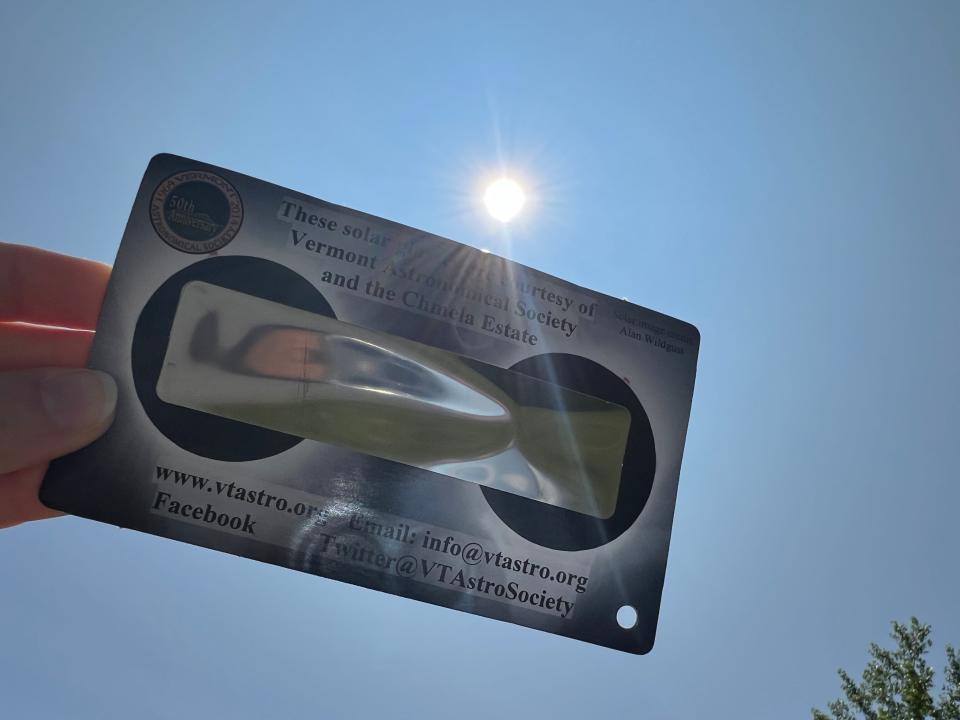
ECHO Leahy Center for Lake Champlain in Burlington and the Fairbanks Museum and Planetarium in St. Johnsbury are tapping into their science programming expertise to plan a full day of activities for all ages, including viewing the phenomenon at their location. More information about these events is in a section below entitled "Brush up on your space and astronomy knowledge in Vermont."
Where to get solar glasses near Burlington, VT
Eye protection is a must for anyone who wants to look up at the eclipse. If you have glasses from a prior solar eclipse − like 2017 or will obtain a pair for the partial solar eclipse coming in October − you can use those. Planners suggest getting them now because supplies could run out closer to the event.
Jack St. Louis of the Vermont Astronomical Society said the key is to make sure the glasses say on them "Meets the Requirement for ISO 12312-2:2015," which ensures the lenses are safe for viewing the sun. There are some manufacturers offering substandard products.
Some local entities will be acquiring and distributing glasses as well.
The ECHO Center plans to get some for the public and to donate to schools. The Vermont Astronomical Society has 5,000 it will be giving out during presentations. Libraries can request up to 2,000 − Fletcher Free Library in Burlington confirmed it is getting some − and some municipalities may also put in a request to obtain some. However, it is unlikely these organizations will receive enough to cover the entire population.
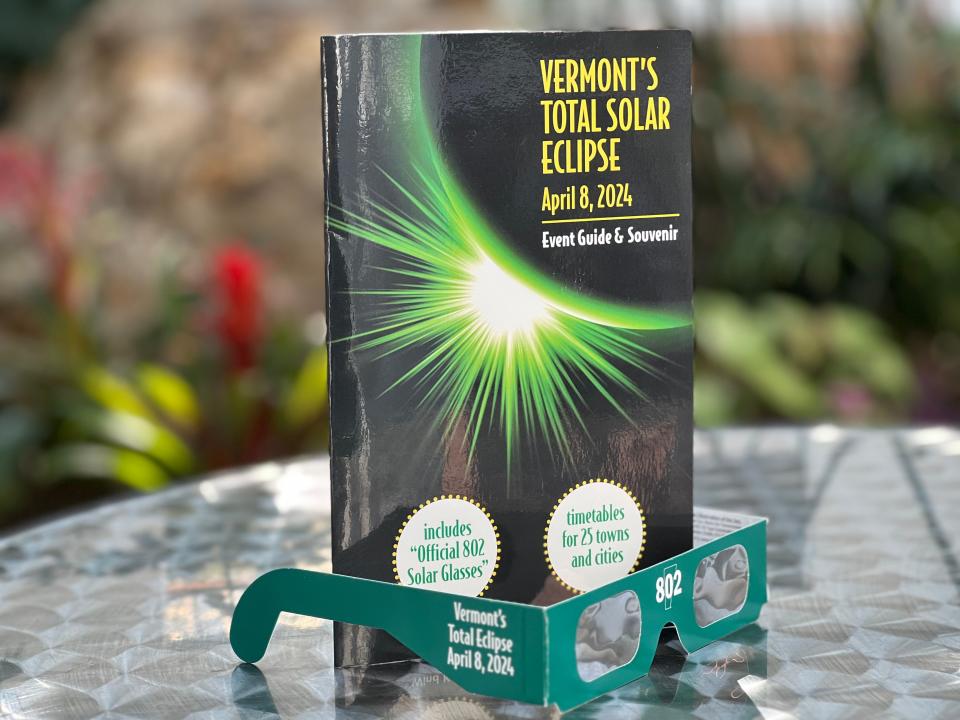
Peter Shea, a local writer of fishing guides and a National Park resource for those with disabilities, has created a Vermont commemorative guide for the event that includes a pair of solar glasses. Vermont's Total Solar Eclipse April 8, 2024 Event Guide & Souvenir can be bought for $12.95 at local bookstores and gift shops including Phoenix Books, Crow Bookshop and Barnes & Noble. The guide includes eclipse timetables for specific Vermont towns, QR codes for national observation of the event, and information on what other phenomena to look for during an eclipse. He prefers sales through local retailers, however, the 12-page book is available directly from his website www.windknotpublishing.com.
And of course, you can also buy solar eclipse glasses online. St. Louis does not support using welder's glasses or camera film to view the sun, which was popular in the past.
Finding amateur astronomy and solar photography equipment
If you plan to buy a new telescope, binoculars, tripod or other equipment that tracks the sun's path across the sky so you don't have to continually find and focus your scope, it's best to buy it now and get in lots of practice. It's easy enough to practice on the sun.
A key piece of equipment will be a solar filter − just like your eyes need solar glasses, your equipment lenses could also be damaged by the sun. For scopes, make sure to put the filter on the very front, and tape it in place so it doesn't fall off, St. Louis says. Once the equipment is protected, your eyes, looking into that equipment, will also be. Solar filters can be purchased for telescopes, binoculars, camera lenses and even smartphone cameras and can run $13 to $150. St. Louis likes the ones made by Orion because those transmit a blue-tinted light versus orange.
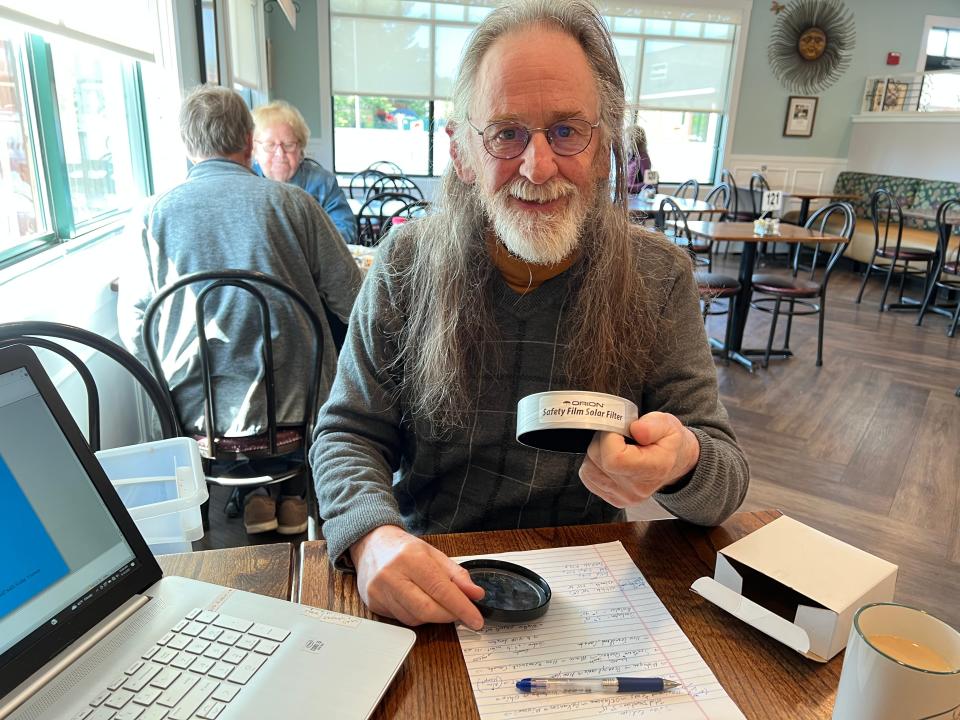
If you want to take pictures of what you're seeing through the telescope, St. Louis suggests a phone holder clamp that mounts to the eyepiece. He recommends setting the camera on a time delay so that any shaking from setting up the shot will have settled by the time the camera takes the picture.
You could also make an optical projector − like a pinhole viewer − or purchase ready-made ones online. Colanders can work and even holes in tree leaves can project little eclipse shapes of light all over the ground. During the 2021 partial eclipse, St. Louis rigged up a funnel to his telescope's eyepiece with a piece of projection screen material clamped over the top. This way a crowd of people was able to see what one telescope was viewing and do it all safely. Here are directions for a similar device: https://skyandtelescope.org/2024-total-solar-eclipse/solar-projection-viewer/.
The Vermont Astronomical Society is available for people wanting to learn to use their equipment or assistance if equipment needs repairs or cleaning. Contact info@vtastro.org or visit vtastro.org.
Vermont eclipses in history: A look back at Vermont's solar eclipse history, and a look ahead to the next total eclipse
Where to view the eclipse - will state parks be open?
Most places in Vermont will offer a good view of the eclipse as it will be almost halfway up the sky (40° altitude) and as long as you have an unobstructed view toward the southwest (233° azimuth) you should be good. If you're thinking of visiting a state park for the day, be aware that some may be closed or hiking areas restricted during that time of year when foot traffic can tear up pathways.
If Vermont gets a cloudy day that day, which it has its fair share of, St. Louis said the experience will still be impressive because it will still get dark, you might feel a drop in temperature of up to 10 degrees and could observe odd animal behavior.
You could always watch the eclipse online. NASA and other organizations will create a link for live eclipse viewing closer to the event.
Will school schedules be modified?
The eclipse happens around the time schools let out for the day and some students could be riding the bus home during the time of totality. The Vermont Superintendents Association said it hadn't heard anything yet from superintendents about adjusting the school schedule or considering closing school for the day yet, but that could be something that comes up.
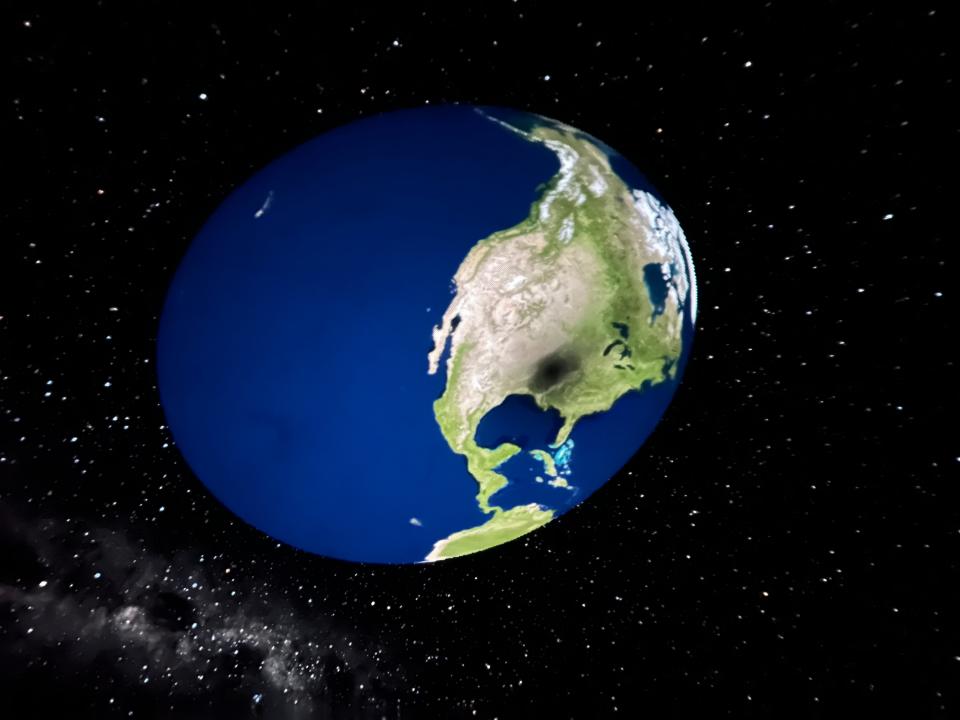
Where to go in Vermont to learn more about space and astronomy knowledge
ECHO Leahy Center for Lake Champlain − 1 College St., BurlingtonECHO is in a group of science centers along the path of totality planning activities in the run-up to the actual event. The center also plans to host a temporary traveling exhibit focused on space science during that time. On April 8, 2024, ECHO is hoping to partner with Burlington City Arts and the City of Burlington for community events hosted in city parks, but those discussions are at the preliminary stages and pending the outcome of city budget approval. The center also hopes to have eclipse glasses on hand for guests.
Fairbanks Museum & Planetarium − 1302 Main St., St. JohnsburyFairbanks, which hosts the state's premier planetarium and provides "Eye on the Sky" forecasts for celestial watchers, has a slew of activities in the works. A museum spokesperson said they expect to welcome a crowd and are eager to make the event spectacular. Eclipse viewing will occur at the museum starting at 2:15 p.m. with totality around 3:30 p.m. in St. Johnsbury. Eclipse glasses will be available to museum guests on the day of and to museum members prior to the eclipse. Check echovermont.org for additional information.In addition, Mark Breen, who is the director of the planetarium, will be joined by Vermont Public to broadcast the event live to radio listeners. Breen will discuss what causes an eclipse and how animals respond. The museum will have additional activities and programs including making pinhole viewers, planetarium programs focused on the sun, and using telescopes to safely view the sky during the day. Visit fairbanksmuseum.org for more details closer to April 8.
The Planetarium Lady in WillistonThe Planetarium Lady, also known as Carrie Cruz, is planning to offer eclipse programming for the next 11 months. This is in addition to constellation stories and science and a tour of the solar system that she already provides at her Williston planetarium and during outreach programs to libraries, recreation centers and schools. The Planetarium Lady also presents planetarium shows for private events for groups of up to 15 people. More information at theplanetariumlady.com.
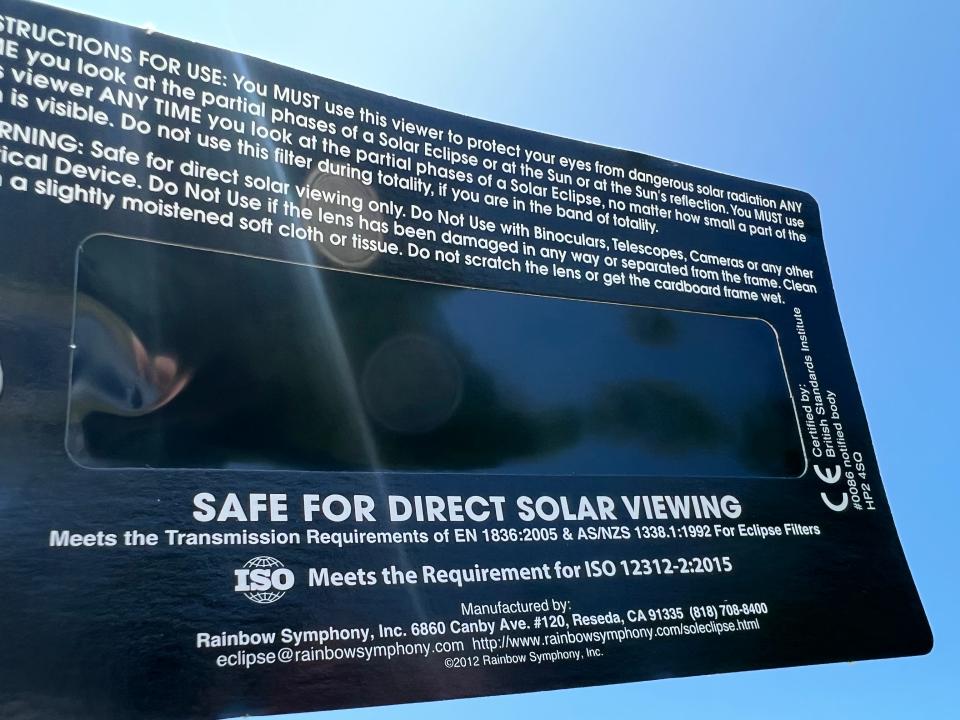
What sun- and moon-themed foods to eat and drink at an eclipse party
Cruz said if you're planning to host an eclipse party, there are some obvious choices for food and drink to have on hand. Drinks: cosmos, Blue Moon beer, moonshine or Sunny D (for the non-alcohol crowd). Snacks/candy: Milky Way, Starburst, Eclipse gum, moon pies, SunMaid raisins, Sun Chips. Food/dessert: chocolate blackout cake, crescent rolls, swiss cheese, sun-dried tomatoes. And, any music playlist would have to include Bonnie Tyler's "Total Eclipse of the Heart."
For more eclipse information, visit the international site eclipse2024.org.
2021's Partial Solar Eclipse in VT: A spectacular view: Vermonters look up to see partial solar eclipse and colorful sunrise
This story may be updated.
Contact reporter April Barton at abarton@freepressmedia.com or 802-660-1854. Follow her on Twitter @aprildbarton.
This article originally appeared on Burlington Free Press: Total solar eclipse in Vermont: How to plan for April 8, 2024

